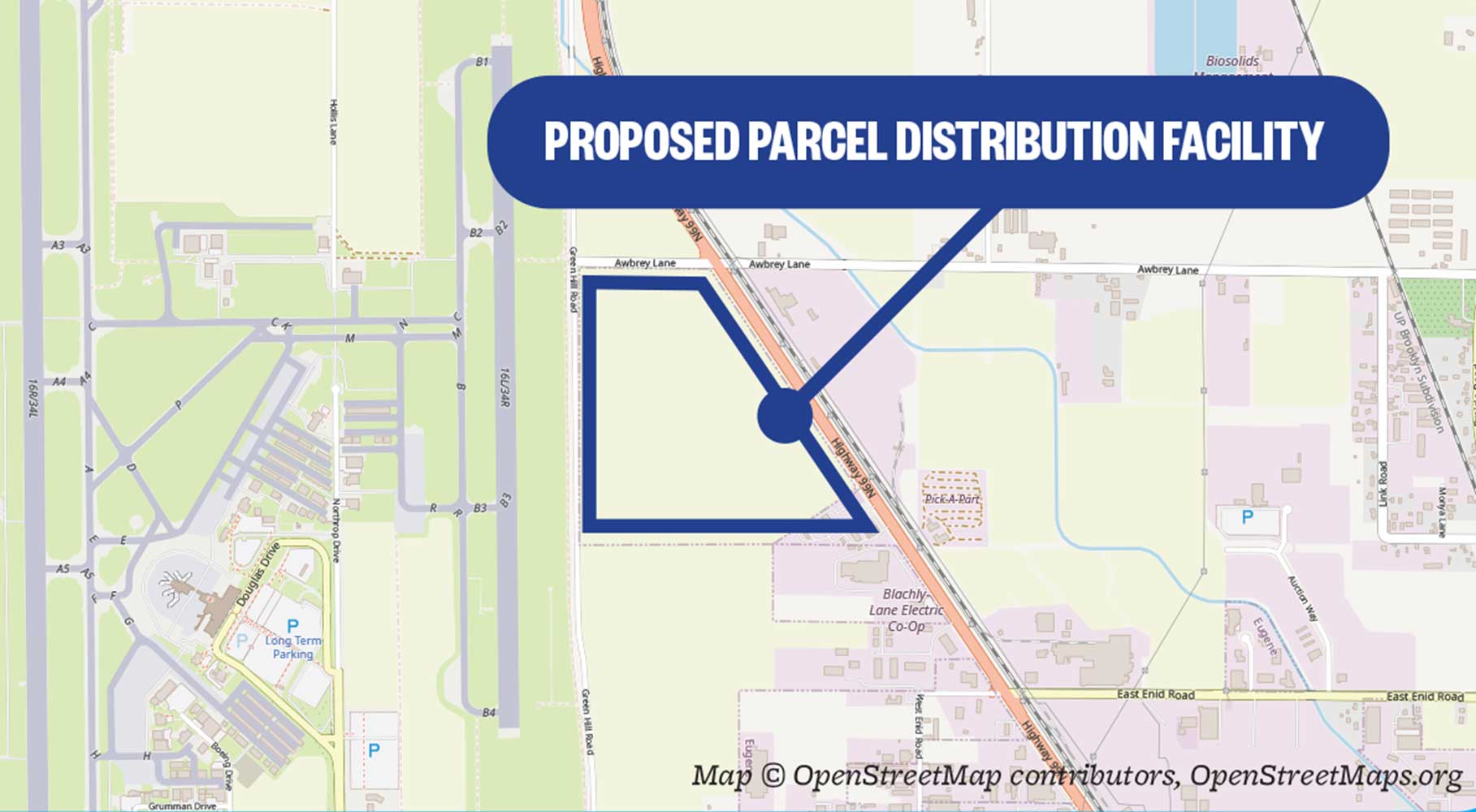Hundreds of area residents are begging someone, anyone — Eugene Mayor Kaarin Knudson, Eugene city councilors, local air protection regulators, state wetlands regulators — to halt the massive parcel-distribution center that’s in the construction permitting stage near the Eugene Airport.
But elected officials and regulators appear toothless.
The center — assumed to be an Amazon facility — will exacerbate air pollution, destroy wetlands and clog airport-area roads, these critics say in hundreds of emails they’ve sent to local officials, including to the Lane Regional Air Protection Agency and the Eugene City Council.
The facility won’t bring well-paying jobs to the area, either, even though high-quality, high-paying job-creation was what the City Council expected in 2018 when it designated airport-area farmland along Highway 99 for industrial development. In documentation justifying that re-designation, city leaders had said they wanted the land to be used for manufacturing, including advanced technology, biotech and food and beverage production. In 2023, city staff told the Oregon Legislature the land was suited for semi-conductor manufacturing.
But a loophole as big as a delivery truck in the city zoning rules also allows “warehousing” and “distribution” on that land. So, a massive local parcel delivery warehouse — a 320,000-square-foot building plus parking for up to nearly 1,400 vehicles — appears to be allowed outright.
Critics say the Amazon facility will offer humdrum truck-driving jobs delivering Amazon parcels to Lane County area homes. Those jobs will simply displace the Amazon delivery work that is already being done here under contract by U.S. Postal Service workers and others, critics fear.
“Is it going to take away good jobs with benefits, and replace them with lesser-paying jobs?” wonders Eugene resident Liz Porter, who has complained to LRAPA and the City Council. “It feels like the city has given away the store,” adds Porter, formerly a manager with the U.S. Army Corps of Engineers.
The Eugene project’s consultants have even given it a fancy sounding high-tech name: it’s an “e-commerce center.” But the plans reviewed by Eugene Weekly show the reality: it is simply a local parcel distribution warehouse, receiving trailer-truckloads of packages, sorting them on a conveyor belt system, and using a big fleet of small trucks to deliver them to area homes and businesses.
About 350 residents have emailed LRAPA — often cc’ing the City Council — asking the agency to deny a permit the facility appears to need for its high-volume vehicle usage. Only four residents sent emails in favor. LRAPA says it is still evaluating what, if anything, it can require of the facility.

No reply
Eugene’s elected leaders don’t want to talk with Eugene Weekly about this can of worms.
The site is in Councilor Greg Evans’ district. He hasn’t replied to EW’s emails and phone messages. Mayor Knudson also hasn’t replied to EW emails. Among the nine Eugene councilors, only one, Eliza Kashinsky, replied to an email asking for an interview on the topic. “I have not gotten into the weeds on this [project], since my understanding is that there is no decision point/approval for [the] Council around this,” Kashinsky says in an email.
Kashinsky seems to be correct.
Because the facility is allowed outright by the zoning code, the city planning staff is processing its building permit application just as it would for a standard single-family home.
When the city in 2018 created the special overlay zone for the newly designated industrial land in the airport vicinity, “a broad variety of uses were anticipated. This planned [package-distribution] development falls into an acceptable use in this carefully planned overlay zone,” says city spokeswoman Lindsay Selser.
“The City has no ability to deny building permits that meet applicable code requirements,” she adds.
In addition to seeking the building permits, the facility’s planning consultants are seeking a permit from the state to fill in about seven football fields worth of wetlands and pay into a wetlands mitigation bank to offset that impact. And they’re seeking an LRAPA air pollution permit.
The applicant’s consultants have meticulously avoided identifying the intended occupant.
But there’s little doubt it’s Amazon. In filings with LRAPA, the consultant says the company has similar facilities up and down the West Coast. Plus, the facility has the size, configuration, equipment and amenities as other Amazon distribution centers nationwide. Amazon hasn’t denied it’s behind the project. It has simply declined to comment.
“The entire proposal was shrouded in secrecy and deceit,” Jessica, who didn’t list her surname, of Eugene’s Whiteaker neighborhood writes to LRAPA.
Advanced tech jobs?
Eugene city leaders have long dreamed of a manufacturing hub around the airport to create high-paying jobs. In 2017, the City Council approved bringing about 650 acres of farmland — including the 84 acres where the distribution center is now proposed — into the city’s urban growth boundary for “light-medium industrial” uses.
The land would be developed for industries such as “clean technology,” “specialized manufacturing” and “biosciences,” the city staff told the council.
Eugene’s Sustainability Commission gave the boundary expansion a thumbs up. The zoning is “intended to promote industries that have been identified as those best suited for Eugene (Clean Technology, Food and Beverage, Advanced Technology, Green Technology, Biotechnology, etc.),” the commission told the council.
But so far, the only substantial project on the farmland is the anonymous parcel-delivery warehouse.
“If this facility is Amazon as so many of us believe, this will not bring good, high-paying jobs to Eugene. Amazon warehouses are low paying and dangerous, even deadly to their workers,” resident Juniper Harwood tells LRAPA in an email.
“It will not bring living-wage jobs to Eugene — Amazon pays poorly,” writes Eugene resident Carey Hilbert.
Some residents disagree.
Drew Emmett tells LRAPA the project “means JOBS for the low-income population of Junction City.” He adds: “Let’s assist this company in every way possible.”
George Worthington echoed: “This proposal will bring a huge employer to this area, supplying hundreds of jobs for an area that desperately needs them.”
But that viewpoint ignores the fact that Amazon has been distributing parcels here for years — contracting with FedEx, UPS and the U.S. Postal Service for the deliveries. Nationwide, Amazon is building its own local distribution centers in order to cut out those contractors and instead have its own drivers and fleets, news reports confirm.
Air permit uncertainty
LRAPA has haggled for months with the project’s main land use consultant, The Satre Group of Eugene, about what requirements, if any, the air protection agency can impose. LRAPA’s rules appear to give the agency the power to require air emissions studies and impose operating restrictions, depending on the facility’s fleet and commuter vehicle volumes. Fleets exceeding 1,000 vehicles draw tougher requirements than smaller ones.
LRAPA at least should require all facility’s delivery trucks be electric vehicles, residents told the air protection agency.
The agency is studying what kind of air impact analysis and other conditions it can impose, LRAPA spokesman Matt Sorenson tells the Weekly. LRAPA expects to reach a decision in coming weeks, he says.
Smog-creating emissions
LRAPA’s so-called “indirect source” permit is rarely needed because so few projects in Lane County have the huge traffic use of the proposed distribution center. The project’s plans show it would have 368 parking spaces for employees and about 1,000 for delivery trucks. The consultants filing with LRAPA say the facility would generate 2,592 vehicle trips per day — an average of about two trips a minute.
The distribution center operator hopes about half the fleet will be EVs, Dan Halverson, a senior planner with Satre, has told LRAPA. Whether LRAPA can require that is unclear.
LRAPA has indicated it wants the applicant to provide a study of the facility’s vehicle emissions of carbon monoxide, reactive hydrocarbon and oxides of nitrogen, emails between the agency and Satre show. Those chemicals contribute to ground-level ozone and smog.
“Our client is now stating that this is above and beyond what we need to do and has not done this for any of their projects in Oregon/Washington/California,” Halverson wrote to LRAPA in mid-August. Such an air pollutants study is not “mandatory,” Halverson wrote, adding, “We would love to get this permit going.”
Halverson did not reply to an EW request for an interview.
Bricks $ Mortar is a column anchored by Christian Wihtol, who worked as an editor and writer at The Register-Guard in Eugene 1990-2018, much of the time focused on real estate, economic development and business. Reach him at Christian@EugeneWeekly.com.
